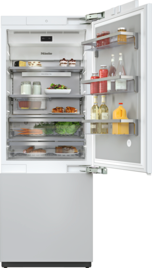Optimum temperature in the refrigerator/fridge zone
It is very important to set the correct temperature to ensure the shelf life of food. Reducing the temperature reduces the growth rate of microorganisms. Food does not spoil as quickly. We recommend a temperature of 4 °C in the fridge zone.
The temperature in the refrigerator/fridge zone increases:
The more often the appliance door is opened and the longer it is kept open.
The more food is stored in it.
The warmer the food is which is being put into it.
The higher the ambient temperature surrounding the refrigeration appliance. This refrigeration appliance is designed for use within specific ambient temperatures (climate range). Do not use in ambient temperatures for which it is not designed.
